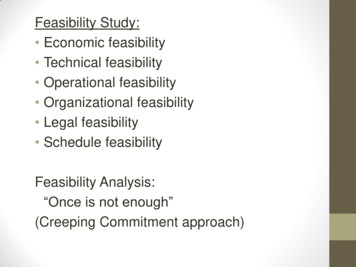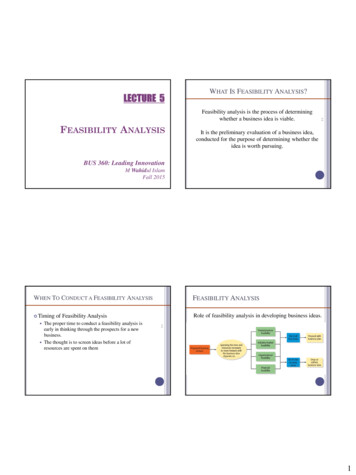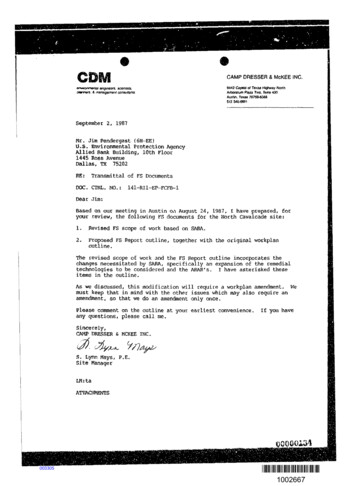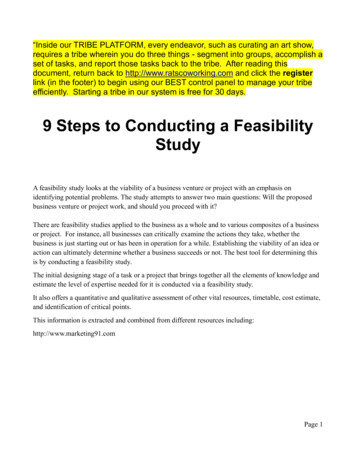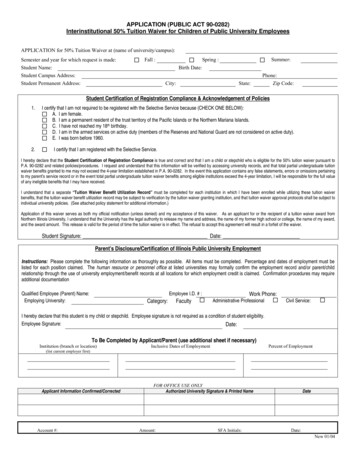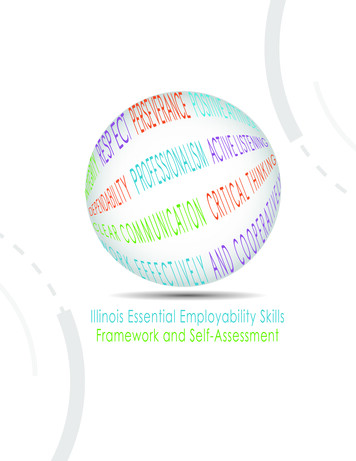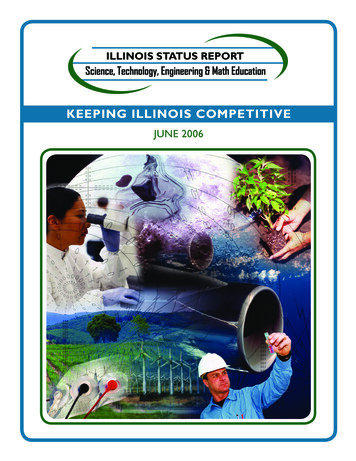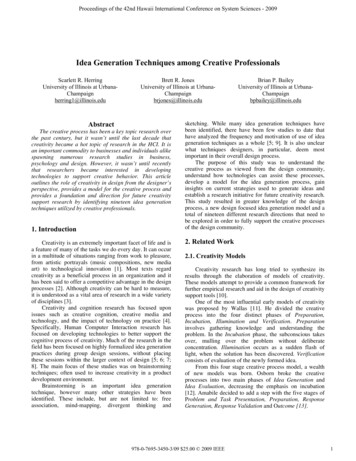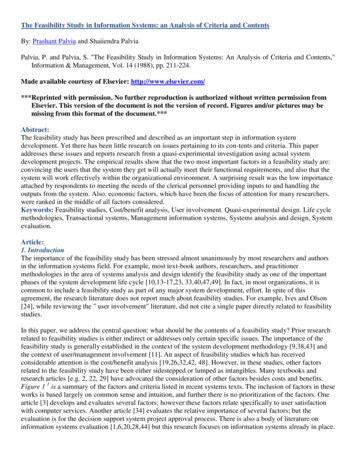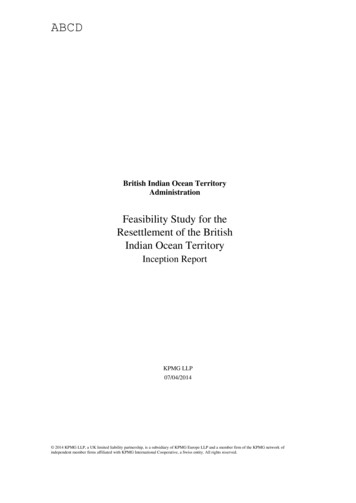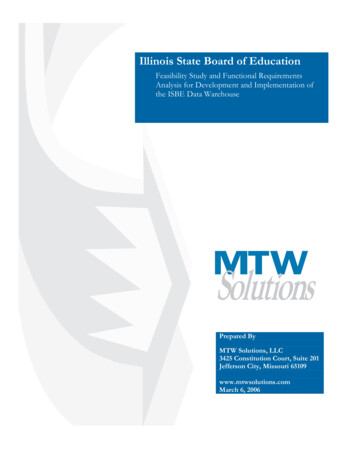
Transcription
Illinois State Board of EducationFeasibility Study and Functional RequirementsAnalysis for Development and Implementation ofthe ISBE Data WarehousePrepared ByMTW Solutions, LLC3425 Constitution Court, Suite 201Jefferson City, Missouri 65109www.mtwsolutions.comMarch 6, 2006
This page intentionally left blank
Illinois State Board of EducationFeasibility Study and Business Requirements for ISBE Data WarehouseINTRODUCTIONOver the past four months MTW Solutions and ISBE have worked closely to examine thebusiness context, needs, challenges, and processes needed to realize a comprehensive datawarehousing solution for Illinois’s State Board of Education. This Feasibility Study represents theefforts of a combined team of ISBE technical and program staff whose time was generouslyshared with our consultants.MTW would in particular like to thank the following individuals:Rebecca WattsChief of StaffGinger ReynoldsUser Project SponsorLinda MitchellTechnical Project SponsorConnie WiseUser Project ManagerTerry ChamberlainData Systems AdministratorDennis PowellTechnical Project ManagerWarren SummersTechnical CoordinatorCandy TaylorTechnical CoordinatorAs described in this Feasibility Study’s findings and recommendations, MTW Solutions believesthat ISBE has the resources, infrastructure and drive to create a “best in class” data warehousesolution that will bring far ranging benefits to the department, staff, and ultimately children ofIllinois education system.Version 1.0 03/10/06ConfidentialPage 3 of 103
Illinois State Board of EducationFeasibility Study and Business Requirements for ISBE Data WarehouseRevision Mv.2.1Submitted03/17/06EL/SMSummary of ChangesSign-OffVersionDateNameSignatureCopyright StatementCopyright MTW Solutions, LLC. ("MTW") 2006.All rights reserved. While every effort has been made to ensure the accuracy,completeness and adequacy of the information contained in this publication, MTW gives no warranties to this effect. The contents ofthis publication are subject to change without notice.Version 1.0 03/10/06ConfidentialPage 4 of 103
Illinois State Board of EducationFeasibility Study and Business Requirements for ISBE Data WarehouseTable of ContentsINTRODUCTION . 3CHAPTER 1. EXECUTIVE SUMMARY. 7CHAPTER 2. GENERAL INFORMATION. 102.1. Purpose . 102.2. Background. 102.3. Scope. 102.4. Targeted Audience and Participants . 112.5. Method of Study. 13CHAPTER 3. INTRODUCTION TO DATA WAREHOUSES . 17CHAPTER 4. ISBE’S DATA WAREHOUSE VISION . 224.1. Overview. 224.2. User Group Profiles . 234.3. Business Requirements of the Data Warehouse . 284.4. Data Requirements – Content of the Data Warehouse. 32CHAPTER 5. ISBE SYSTEMS . 33CHAPTER 6. THE IMPACT OF THE DATA WAREHOUSE . 436.1. Overview. 436.2. Benefits of Building the Data Warehouse . 436.3. Risks of Building the Data Warehouse. 446.4. Privacy, Security and Confidentiality. 466.4.1. Systems of Data Protection . 47CHAPTER 7. BEST PRACTICES . 527.1. Summary of Best Practices. 527.2. Profiles of Related Systems in State Education Agencies . 567.2.1. Nebraska Department of Education . 567.2.2. New York State Education Department. 567.2.3. New Jersey Department of Education. 577.2.4. Wyoming Department of Education. 577.2.5. Georgia Department of Education. 587.3. Data Quality Campaign. 59CHAPTER 8. RECOMMENDED APPROACH . 618.1. Introduction . 618.2. The Data Warehouse Infrastructure and Environment. 628.3. Data Extraction, Transformation and Loading (ETL). 648.4. Online Analytical Processing (OLAP). 658.5. Report Creation and Distribution. 678.6. Phased Implementation . 67Version 1.0 03/10/06ConfidentialPage 5 of 103
Illinois State Board of EducationFeasibility Study and Business Requirements for ISBE Data Warehouse8.7. Historical Data Loads. 698.8. External Data Loads . 708.9. Security, Privacy and Confidentiality. 708.10. Cultural and Organizational Changes . 718.11. Impact on Existing Data Collection Reporting Systems . 728.12. Hardware and Software Recommendations . 738.13. Precursor Tasks. 748.14. Solution Options. 74CHAPTER 9. DATA MODEL, DFD & SOLUTION ARCHITECTURE . 769.1. Data Flow Diagrams . 769.2. Data Model . 869.3. Solution Architecture. 1CHAPTER 10. COST ANALYSIS . 310.1. Hardware . 310.2. Software. 410.3. Development. 510.4. Project Management. 510.5. Training. 610.6. Annual Recurring Maintenance Costs. 610.7. Total Estimated Pricing . 610.8. Budgeting Considerations. 7CHAPTER 11. NEXT STEPS . 811.1. Identify a Strong Project Sponsor . 811.2. Develop a Unique Identifier System. 811.3. Determine the level of personally identifiable student information . 811.4. Complete Phase II of the SIS. 811.5. Determine and Implement a Data Stewardship Function. 911.6. Define and Document Privacy and Confidentiality Policies. 9APPENDIX A – GLOSSARY. 11APPENDIX B – FERPA SUMMARY . 14INDEX. 15Version 1.0 03/10/06ConfidentialPage 6 of 103
Illinois State Board of EducationFeasibility Study and Business Requirements for ISBE Data WarehouseCHAPTER 1. EXECUTIVE SUMMARYThe Illinois State Board of Education (ISBE) has recognized the necessity to broaden its currentdata collection and analysis systems to include a data warehouse. To initiate the process ofbuilding an integrated data system ISBE contracted for the conduct of a comprehensive feasibilitystudy. Through the Request for Sealed Proposal process, ISBE selected MTW Solutions, LLCand subcontractor eScholar, LLC to author this feasibility study and functional requirementsanalysis.Following a kick-off meeting in late November and ISBE’s approval of the project governancedocuments, MTW Solutions began an in depth data collection and analysis phase that includedinterviews with the IT Steering Committee and the business and technical owners of the majorsystems targeted for inclusion in the data warehouse, state board member, designated districtsuperintendents, a regional superintendent and two state legislators. The data collection phasealso included interviews with representatives from five state education agencies that haveimplemented data warehouse or related systems to identify industry best practices and gatherdetails about their systems. Simultaneously, the MTW Solutions project team completedadditional research to define potential data warehouse system solutions and began to construct ahigh-level architecture, a data flow diagram, and data model for an ISBE data warehouse.Through the data collection phase, a vision of an ISBE data warehouse - who would use it, how itshould function, what data it should include - began to emerge. (Refer to Chapter 4 ISBE’s DataWarehouse Vision.) The anticipated users include ISBE staff and board members, District staff,the media, research organizations, legislators, and the general public. Each of the user groupswill access the data warehouse for purposes ranging from a parent seeking general informationabout a school district they hope to enroll their children in, to an ISBE staff member preparing adetailed report for EDEN reporting. To meet the needs of the broadest spectrum of ISBE userneeds the data warehouse could function as:A strategic decision making toolA clearinghouse for dataA tool for unifying the fragmented data maintained by ISBEAn instrument for facilitating communication throughout the agencyA mechanism for reducing support call volume, andA tool for generating State and Federal ReportsA data warehouse functions by pulling data from currently existing systems within ISBE, as wellas incorporating external data, and housing all data in separate but inter-related databases. Afterthe data are extracted from the source systems and transformed and loaded into the datawarehouse, users can access the information by either accessing pre-defined reports, completingqueries from the data warehouse or extracting the data to complete more detailed analysis usingother software solutions. ISBE has over 200 data systems in place with 100 of these systemsVersion 1.0 03/10/06ConfidentialPage 7 of 103
Illinois State Board of EducationFeasibility Study and Business Requirements for ISBE Data Warehouseoperating online. To successfully build the data warehouse with data that will maximize theoperation of the data warehouse, the MTW project team along with ISBE system ownersnarrowed the number of data collections to 20 systems that will be primary systems for inclusionin the data warehouse. (Profiles of these systems can be found in Chapter 5 ISBE Systems.)Each of these source systems functions and stores data differently, and requires an evaluation ofhow to best extract the data from the system and transform and load it to the data warehouse.This process is illustrated through the use of data flow diagrams, data models and a datawarehouse solution architecture diagram. These illustrations can be found in Chapter 9 DataModel, DFD & Solution Architecture.A data warehouse will have significant impact on the operations within ISBE. As an example,ISBE management will need to increase their focus on defining data collection practices andcommunicating the data quality standards through improved training programs both inside andoutside the agency. This improvement in training and related policy development will facilitate theloading of high quality data into the data warehouse and have significant impact on the successand use of the data warehouse. Other risks and benefits impacting the ISBE are addressed inChapter 6 The Impact of the Data Warehouse.In determining how to best implement a data warehouse ISBE can draw upon a wealth ofknowledge and experience gained by other education agencies as they navigated through thetangible and intangible issues of constructing a longitudinal data system. Through generalresearch and interviews with representatives of state education agencies from Nebraska,Georgia, New Jersey, New York and Wyoming, the MTW Solutions project team identified bestpractices used in education data warehouse projects, as well as identified those events that canderail a project similar to ISBE’s data warehouse project. (A summary of best practices andprofiles of the five interviewed states can be found in Chapter 7 Best Practices.) ISBE alsobenefited from the expertise and contribution of Shawn Bay, president of eScholar and one of theleading experts in education data warehouses. He is recognized as one of the pioneers of datawarehousing and has played a significant role in the development of tools and processes used indata warehousing both in corporate America and throughout the education industry.Drawing upon all the resources and information gathered through the data collection phase, theMTW Solutions Project Team structured a recommended approach, identified next steps anddeveloped a cost analysis for the ISBE data warehouse initiative. The MTW project teamidentified the tools required to build and maintain the data warehouse and the criteria that shouldbe used in evaluating vendors’ solutions. The overall approach to building a data warehouseincludes the recommendation of using a phased implementation for building the data warehousethat will enable ISBE to spread the cost and impact on staffing resources over a period of severalyears. Before moving forward with the project and clarifying the requirements of the datawarehouse, ISBE technical, program and management leaders will need to consider and resolvea large number of issues impacting the data warehouse project. Details of these issues withrecommendations for addressing them can be found in Chapter 8 Recommended Approach andVersion 1.0 03/10/06ConfidentialPage 8 of 103
Illinois State Board of EducationFeasibility Study and Business Requirements for ISBE Data WarehouseChapter 11 Next Steps.Costs for the implementation of a data warehouse fall into six main areas: hardware, software,development, project management, training and annual maintenance. Software and developmentwill be the two largest cost areas. Cost estimates, discussed in Chapter 10 Cost Analysis, outlineboth a low and high range of pricing in each of these areas and assume all services and productswill be purchased by ISBE specific to the data warehouse effort. Should ISBE’s ultimate solutioninclude existing hardware, software and the inclusion of ISBE development and managerial staffthen these estimates will need to be revised accordingly.Version 1.0 03/10/06ConfidentialPage 9 of 103
Illinois State Board of EducationFeasibility Study and Business Requirements for ISBE Data WarehouseCHAPTER 2. GENERAL INFORMATION2.1. PurposeIn November 2005, the Illinois State Board of Education made a decision to assess the feasibilityof building and implementing a data warehouse and identify the requirements of such a system.MTW Solutions, LLC was contracted to undertake a review of currently available data, identifydata gaps, and suggest steps for moving forward. This document is in response to that charge.2.2. BackgroundIn September 2005, as an initial step in this effort, ISBE issued an RFSP for the conduct andcompletion of a Feasibility Study and Functional Requirements Analysis for the Development andImplementation of an ISBE Data Warehouse. On October 27th ISBE notified MTW Solutions thatthey, and their partner eScholar, were the selected vendors for performing this work.Starting in mid-November with an initial on-site kickoff meeting, MTW began conducting a seriesof interviews with the IT Steering Committee and the business and technical owners of the 20major systems targeted for inclusion in the data warehouse, designated district superintendents,and two state legislators. From these interviews, MTW Solutions began documenting both thebusiness context of the data warehouse and potential solution areas.Based on the business requirements, user group profiles, and existing system infrastructuredocumented during the discovery process, MTW began an evaluation and analysis of the issuesand challenges uniquely facing ISBE in the realization of an enterprise data warehouse solution.2.3. ScopeIn keeping with the requirements of the RFSP for the Feasibility Study, the scope of this studyincludes the following:1. Identifying existing ISBE data collection systems that can be discarded or that can bemodified or developed to draw data from the data warehouse system thereby reducing thedata burden placed on districts.2. Clarifying ISBE’s vision for Data Warehouse by defining the business context and impacton the ISBE organization.3. Identifying privacy and confidentiality issues related to development and implementation ofa data warehouse. Develop standards and procedures that will guarantee the security andconfidentiality of the data stored and maintained in the data warehouse system under theprovisions of the federal Family Educational Rights and Privacy Act (FERPA) (20 U.S.C. §1232g; 34 CFR Part 99), and the Illinois School Student Records Act (105 ILCS 20/).Version 1.0 03/10/06ConfidentialPage 10 of 103
Illinois State Board of EducationFeasibility Study and Business Requirements for ISBE Data WarehouseThese standards and procedures will include who has access to the system at both thestate, regional, and local levels, how authorized users gain access to the system, and howdata will be entered or imported into the system.4. Developing user-group profiles that include reporting needs by data area, requirementsand how they will access the system.5. Identifying and discuss the impact, risk and issues of developing a data warehousesystem.6. Investigating and document requirements for disaster recovery for the data warehousesystem.7. Defining potential data warehouse systems by identifying best practices for datawarehouse systems in state education agencies.8. Defining potential data warehouse system solution areas and provide recommendations ineach area. Identify infrastructure, hardware, and software requirements for the datawarehouse system. This documentation will include criteria for selecting report creationand distribution software, OLAP tools and data extraction, load and transformation (ETL)tools that can be utilized by personnel at the state, regional, and school district levels.9. Developing a data model, data flow diagram and solution architecture for a datawarehouse.10. Formulating a cost analysis for the data warehouse system11. Providing direction for next steps that identify activities and tasks that need to becompleted before the data warehouse can be constructed and implemented.2.4. Targeted Audience and ParticipantsThis Feasibility Study document is targeted to the Data Warehouse Feasibility Study project teamand those individuals internal and external to the agency who will play a part in the subsequentreview of the data warehouse project and those who will play key roles in the decision to moveforward with the design and implementation of the data warehouse. This document assumes abasic understanding of ISBE data collection and system processes. Realizing that the conceptsand terms of data warehousing may be unfamiliar to readers, this document includes anintroduction to data warehouses and also includes a glossary of terms at the end of the document.Those users of the document with little or no knowledge about data warehouses are encouragedto review the Introduction to Data Warehouses chapter and glossary before reviewing the rest ofthe document.Version 1.0 03/10/06ConfidentialPage 11 of 103
Illinois State Board of EducationFeasibility Study and Business Requirements for ISBE Data WarehouseThe following groups and individuals generously committed their time and energy in assistingMTW Solutions in the discovery, analysis and management of the Feasibility Study:ParticipantsDonna Luallen, HenriFonville, Eric Thatcher, RichLoman, Rich Dehart, SherylBradleySteve Rothenberg, RhondaRobinson, Pat BrennanLilibeth GumiaAndrea BrownAreaAccountabilityMike KellyDennis Williams, LynnRhoades, BrendaStonecipher, SharonBattles, Marti WoelfleJeff AranowskiPat Folland, Ann HortonCarlinville Public SchoolsCertification and Professional PreparationWarren SummersRobin Lisboa, BethRobinson, Feng NaolhoRobert WolfeMyron MasonGail SteinhourLinda MitchellMelissa OllerTim ImlerJonathan FurrDeborah ScheiterAdministrative ServicesBilingual, Regional Safe SchoolsBoard MemberChicago ROE ServicesChicago Special Education ComplianceMonitoringData SystemsEnglish Language LearningExternal AssuranceFederal Grants and ProgramsFederal proposals and reportingFinancial ServicesFiscal ServicesFunding and Disbursement ServicesGeneral CounselInternal AuditDennis PowellChris SchmittGinger ReynoldsISBE SISNutrition Programs and Support ServicesProject SponsorDr. KuzneweskiDeborah VespaBeth HanselmanBecky McCabeRockford Public SchoolsSchool Business and Support ServicesSpecial Education Services – SpringfieldStudent AssessmentScott NortonTechnology SupportVersion 1.0 03/10/06ConfidentialPage 12 of 103
Illinois State Board of EducationFeasibility Study and Business Requirements for ISBE Data Warehouse2.5. Method of StudyWorking with the IT Steering Committee, MTW Solutions worked to establish project governancedocuments and standards. These governance documents included a description of major tasksand deliverables, roles and responsibilities, specific methods of communication, and statusreporting. A project plan was established detailing a work breakdown structure, milestones anddeliverables, roles and responsibilities, and change and issue management. The following projectplan was used to guide the Data Warehouse Feasibility Study to completion.Version 1.0 03/10/06ConfidentialPage 13 of 103
Illinois State Board of EducationFeasibility Study and Business Requirements for ISBE Data WarehouseVersion 1.0 03/10/06ConfidentialPage 1 of 103
Illinois State Board of EducationFeasibility Study and Business Requirements for ISBE Data WarehouseDuring November and December, MTW Solution’s analysis team conducted onsite interviews withISBE project sponsors, IT staff, business users, and representatives of the state, regional andlocal level users. The information gathered in the user group profile sessions has been analyzedand summarized to describe the identified business context of the data warehouse, thecomposition of data to be captured, and the types of issues and answers the system is toaddress.Concurrent with this process, MTW Solution’s technical staff worked with ISBE’s IT staff to gainan understanding of ISBE’s technical and application infrastructure. These findings have beenused to compile this feasibility study’s analysis of how existing systems will interface with the datawarehouse, as well as where systems and infrastructure will need to be strengthened andenhanced to support a robust data warehousing solution.Version 1.0 03/10/06ConfidentialPage 16 of 103
Illinois State Board of EducationFeasibility Study and Business Requirements for ISBE Data WarehouseCHAPTER 3. INTRODUCTION TO DATA WAREHOUSESA data warehouse is “a copy of transaction data specifically structured for query and analysis.” RalphKimball, The Data Warehouse Toolkit.From the earliest development of mainframe systems, the systems rarely stored historical dataand the data was often stored in complex formats and was difficult to access. As the developmentof computer applications expanded, the complexity and differences of how data was collected andstored exploded, often creating silos of information within an organization, with little or no way forthe organization to use the collected data from these systems for analysis and/or decisionmaking. In the late 1980’s, the concept of bringing together data in a common environmentevolved into the use of the term “data warehouse”. (Project Team Consultant Shawn Bay isconsidered one of the pioneers of data warehousing and has been active in data warehousingdevelopment since the mid 1980’s while working with Procter & Gamble and Unilever.) Accordingto Bill Inmon in a Byte.com article entitled Wherefore Warehouse, “Data warehouses squarelyaddress these inadequacies of the operational environment by integrating data, providinghistorical data, and providing detailed as well as summary data.”A data warehouse provides a means to use compiled data as a decision support system orknowledge-based applications architecture. A decision support system is a term that refers toan interactive computer application that can be used to gather and present data from a variety ofsources. The results of the gathered information can be used for decision-making purposes.Knowledge-based applications architecture is process of using two components, a knowledgebase and inference engine to solve problems or make decisions by using knowledge andanalytical rules defined by experts in a particular field.The data or pieces of information in the data warehouse can come from disparate systemsincluding mainframe legacy systems, Web-based operational or transactional systems or even asimple Microsoft Excel Spreadsheet. The data warehouse ISBE is considering will bring togethera variety of information including student, teacher, staff, financial and performance data.Currently, ISBE has over 200 systems in place with 100 of these systems operating online.Bringing together data from various sources requires considerable planning. At a minimum, it isnecessary to identify the types of data that need to be collected, and define the meaning of thedata elements, so that there is consistency throughout the organization of how the organizationinterprets particular types of data. Also factoring into the identification of types of data to include inthe data warehouse is how the organization will use the data warehouse as a decision supportsystem. This includes defining the type of reports and queries that the organization needs toobtain from a data warehouse.Version 1.0 03/10/06ConfidentialPage 17 of 103
Illinois State Board of EducationFeasibility Study and Business Requirements for ISBE Data WarehouseOne of the earliest steps in the development of a data warehouse is to define the data warehousearchitecture. This architecture defines the elements and services of the data warehouse. Forexample, it will illustrate how the data will come together, how it will be transformed and how andwhere it will be stored. Below is an example of a data warehouse architecture diagram.1The architecture of the system can vary. A construct known as the operational data store canbe used to create an additional source of information that is separate fro
additional research to define potential data warehouse system solutions and began to construct a high-level architecture, a data flow diagram, and data model for an ISBE data warehouse. Through the data collection phase, a vision of an ISBE data warehouse - who would use it, how it should function, what data it should include - began to emerge.
